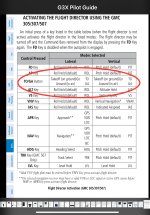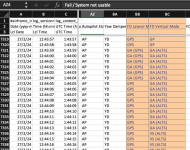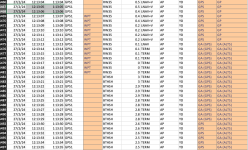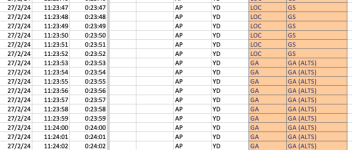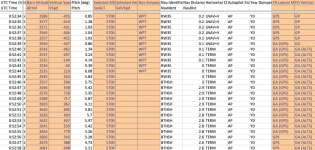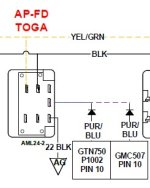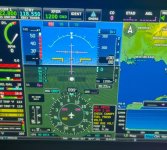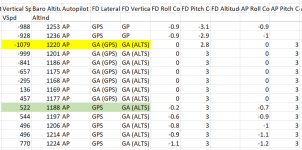Gents,
I'm not ruling out a CONFIG, system, or wiring problem. But, It could be everything is working. You asked about what to expect, I am offering this.
There is a very good book by Max Trescott; "GPS WAAS Instrument Flying". The info is based on the G1000 paired with 430/530 navigators. The G3X is a G1000 "light" system. Setting aside the touch screen, 430/530 navigators function sequence is nearly the same as the GTN650. This may clear up what you are observing.
When on the ground pressing the TOGA button will raise the FD command bars to the default pitch for climb. If HEADING is engaged there will be commands to the BUGed heading, as well as level off if an altitude is pre-selected. An engaged AP will follow the FD commands.
In APPROACH mode the navigator is programed to keep the aircraft on course in the protected corridor. At low altitude there can be lateral obstructions that prevent turning until altitude clearance. If so, missed approach procedures have a minimum altitude based on the area past the Missed Approach point and height clearance of the lateral obstruction. The Navigator will not initiate a missed approach turn until at or above the "Climb to ___then..." altitude. If in the Approach Mode on the final leg the navigator will not begin a turn until past the DA/MISSED fix and above the "Climb to" altitude.
There are distinct differences in the NAV corridors of VHF and GPS approaches. Be sure to use a GPS chart. The missed procedure can be very different.
Make sure you have current NAV data in the navigator. If expired the navigator will not desend beyond the FAF. After entering the terminal area of an approach the navigator automatically checks GPS/WAAS signal integrity. If below minimum requirements, again it will not desend beyond the FAF.
Additionally, while on the final leg to either DA/MISSED, or inbound to a Hold fix, on the lower GTN status bar a square with "SUSP" will appear. This means auto leg sequencing is SUSPended. If not cancelled before reaching the fix the navigator will continue on the current track.
I hope this helps.
Cheers!
Thanks for the suggestion. ill check it out.
However... and please dont take this the wrong way - you have neatly provided another example of what caused me all my issues.
A G3X Touch connected to a GTN Xi and GFC500 in an experimental is an integrated system that is FAR more advanced and capable than any non NXi G1000 or 430/530 with autopilot X. Its the complete reverse of being a G1000 "light" and many people - including instructors - incorrectly assume that they are somehow feature limited but the button pushing is the same.
Sure the buttons have the same names and do similar things, but the devil is in the details - and the details aren't documented and/or they are hard to find. See my comment above about having GP and VNAV armed concurrently in ALT Hold mode.
This whole odyssey of frustration started when I did my renewal last year. The instructor was adamant that the AP would capture the GP at the IF while in ALT mode and all would be good. Needless to say - It obviously didn't - and his response was basically, well that's how the G1000 in the 2008 cirrus (G2 or G3 don't know what AP) does it so your config is wrong or you avionics aren't as good a the 15yo cirrus - so I'm going to make you fly it in VS mode until you capture the FAF alt sometime before the FAF then it'll transition yada yada.
Completely oblivious to the existence of enhanced VNAV or Transition to approach that would take you right to the FAF on a 3 degree path and seamlessly transition you to GP.
So in a nutshell - the problems all stem from being taught with the old stuff, with procedures for the old stuff, that don't work with the new stuff or ignore their capabilities. I did my IR 10y ago with a 430. Dont miss that box at all.
There are subtle but important differences in how all the current iterations of the Garmin suites operate between Certified and experimental installs. Let alone legacy avionics
G1000NXi/GFC700, G500TXi/GTNXi/GFC600, G3XT/GTNXi/GFC500 in an STC, G3XT/GTNXi/GFC500 in an experimental all have subtle feature differences.
Mehrdad found this out when he asked support. Even they didn't know. So how are Instructors or pilots supposed to?
As Waiex guy mentioned above, one consideration is whether the missed approach procedure immediately *requires* a turn at the moment the TO/GA button is pushed. ”Climb straight ahead until reaching xxxx altitude, then turn right…” The other missed approach gotcha that has claimed more than one life is that you should not initiate any turns until you reach the missed approach point. Climb, yes, but an early turn might have you flying into an obstacle or terrain.
I fly an Airbus at work and one of the things we have hammered into us in all phases of training is to pay attention to what Airbus calls FMA’s. Flight Mode Annunciation. Selecting something using the autopilot control panel doesnt become reality until you see it via an FMA. When the hope versus the reality doesn’t match, it could be as simple as missing a button with your finger or it could be that you’ve asked the autopilot to do something that it can’t (or won’t) do at that moment.
Push a button or turn a knob and then look to the appropriate display to make sure it Really happened.
I can’t wait to fly the G3x system I’m installing in my Glasair!
Good reminder to double check the mode on every button push.
Bringing it back to the OP question at hand-
Lets assume that everyone is following the procedure as its designed. The database is current, nobody early turning before the MAP etc. the modes have all been selected properly and verified.
Yes do think that the proximity of a turn after the MAP could be a factor. There was no "course to altitude" legs in either missed approach.
In the 12 second delay example the missed procedure is runway heading and climb to 3000 AGL. No great urgency. No real chance of getting too far off the missed approach course.
In the 2 second example there is an immediate right turn at the MAP. however there was no great rush there either as I went missed 1.5NM before the MAP and crossed the MAP 30seconds later - but there would have been if I flew level at the MDA for 1.5NM first before pushing TOGA.
But logically, if you are climbing and you are on the inbound course to the MAP still or on the missed course, why wait. Just transition the lateral mode from GA straight back to GPS. 12 seconds just makes you sweat unnecessarily IMHO. Unless there's a decent reason.
Edit...didnt see Justins reply ahead of me. AGL sounds sensible!
Ill email the flight file through. Would be great to get some more insight. Much appreciated.



